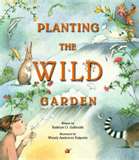 Everywhere in my yard, plants are growing, many of which I didn’t plant (some call them weeds, I call them uninvited green guests.) How do all those plants in the meadows, by the creek beds, in fields, and by the sides of roads get there? In Planting the Wild Garden written by Kathryn O. Galbraith and gorgeously illustrated by my friend Wendy Anderson Halperin, we learn that we helped those plants: “wind and water. Birds and animals. Plants and people. All of us. Together.”
Everywhere in my yard, plants are growing, many of which I didn’t plant (some call them weeds, I call them uninvited green guests.) How do all those plants in the meadows, by the creek beds, in fields, and by the sides of roads get there? In Planting the Wild Garden written by Kathryn O. Galbraith and gorgeously illustrated by my friend Wendy Anderson Halperin, we learn that we helped those plants: “wind and water. Birds and animals. Plants and people. All of us. Together.”
I love Galbraith’s easy, poetic style for nonfiction. This book doesn’t read like an old science text book, although it is bursting with information. Scotch broom seeds pop out like popcorn in the heat, cockleburs are transplanted when they catch on the fur of a fox, and dandelion seeds are blown to new places by a child. Each page is lushly and accurately illustrated by Halperin, whose award-winning project drawingchildrenintoreading.com is worth investigating if you are an educator or parent of budding readers. After reading this book aloud, give students colored pencils and paper for them to draw the seed transportation method they find most interesting. Read the book aloud twice as children draw, rereading pages students want to hear. Students can practice and demonstrate their listening comprehension through their art. Encourage them to use labels and descriptions to explain their art, and to use onomatopoeia like Galbraith did to build writing skills. Whether this is part of a science unit on plants, a celebration of Earth Day, or a lesson to build listening comprehension, Planting the Wild Garden will plant a love of nature in young learners.
For more inspiration, please visit Kathryn Galbraith’s website: kathrynogalbraith.com and Wendy Anderson Halperin’s website: wendyhalperin.com.